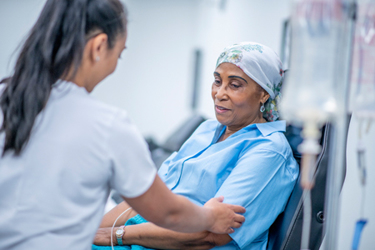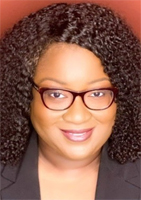Janssen and Stand Up To Cancer Collaborate For Oncology Patient Diversity

By Ed Miseta, Chief Editor, Clinical Leader

In June 2022, Stand Up To Cancer® (SU2C) announced sponsorship of an initiative with the Janssen Pharmaceutical Companies of Johnson & Johnson to increase the participation of patients from medically underserved communities in oncology early phase clinical trials. Including patients from all racial and ethnic communities is important to advancing cancer treatments. Still, only 6% of trial participants are Hispanic and only 5% are Black. If those inequities are not addressed in Phase 1 and Phase 2 studies, it could impact access to potentially innovative therapies.
I spoke to Lisa Lewis, Director, Diversity, Equity, & Inclusion in Clinical Trials - Oncology at Janssen Research & Development about the sponsorship, what the collaboration hopes to accomplish, and how it may impact the inclusion of underrepresented and underserved patients in clinical trials.
Ed Miseta: Tell me about this collaboration with SU2C.

On a personal level, I spent a fair amount of time working in the early oncology development space, and I have seen the inequities that exist in oncology Phase 1 and Phase 2 trials. I have seen how, even in a disease state such as prostate cancer or breast cancer, where there are well-documented disparities among certain underrepresented and underserved groups, the body of data was still monolithic. By supporting this program, it gives us an opportunity to continue to live up to our vision of supporting diversity in clinical trials, regardless of the phase, and deliver upon Our Credo to care for all the communities we serve.
Miseta: I understand the public awareness of clinical trials needs to improve. Still, it surprises me that trial participation in oncology is not greater than it is.
Lewis: It is surprising as well as challenging. For that reason, we must try to move the needle from a couple of different angles. When someone is diagnosed with cancer, you would hope the whole menu of potential treatment options would be presented to them by their healthcare provider, physician, or nurse practitioner, or that a newly diagnosed patient with cancer would be aware of clinical trials as an option. Sadly, many people are not aware of clinical trials. Some patients are not offered trial opportunities because of assumptions about their willingness to participate. Most of us are also aware of the unfortunate history of medical and research injustices affecting communities of color and how such inequities persist today. As a result, there is also justifiable hesitancy and distrust that exists in various populations.
There are multidirectional issues that are well documented that impact the health system in general and in turn impact the disparities we see in clinical trials. Still, we need to move past the assumption that we can't overcome these issues and educate patients on the benefits of clinical trials. We just need to make the effort. Recent studies have found people from marginalized racial and ethnic communities and minoritized populations are not offered clinical trials in oncology and other therapeutic areas in equal measure to other ethnic groups.
Miseta: What can be done to change that situation?
Lewis: I think we can continue to build trust by partnering with community organizations and ensuring our materials are fit for purpose so people can understand what we're trying to convey. Trial sponsors also need to support providers so they can have conversations with any patient that comes through the door and support patients and their families to be knowledgeable and comfortable about considering clinical trials as a potential option. I believe a program like this one with SU2C will be able to help us move toward achieving some of these goals.
Miseta: Building trust in communities will be a critical part of recruiting patients from groups that are underserved or underrepresented in clinical trials. How can sponsor companies do that effectively?
Lewis: Community engagement is critical to clinical trial awareness. At Janssen, we have Research Includes Me TM, a website and patient-facing clinical trial education and awareness platform. We have mobile units that travels to community events across the country. During the COVID-19 pandemic we deployed our mobile health units across the country to discuss clinical trials. We did not discuss a specific study or a specific disease area. We just wanted to make sure people understood the purpose of clinical trials and why it’s important to have diversity in clinical trials. Our Research Includes Me TM tagline is: “Who Should Be Included in Clinical Trials? Everyone.”
Within Janssen and our strategic partnerships across oncology and other therapeutic areas, the goal is to bring the message of clinical trials to the people. We need to build relationships with groups that already have the trust of the community. It can be religious or civic organizations, universities, social organizations, or any groups where people gather and trust the input of the leaders and trusted advisors in these groups. Those are the organizations we collaborate with, and we have folks on the ground getting the message out. If we continue to do that, we can move closer to our goal of closing the clinical trial recruitment gap that exists.
Miseta: The collaboration with SU2C hopes to increase diversity in Phase 1 and Phase 2 trials. Is the hope that those patients who are engaged early will choose to participate in Phase 3 trials as well?
Lewis: Yes, the hope is that the SU2C program will help to engage and educate communities and highlight the importance of all phases of clinical trials. In the past, many diversity efforts were focused on later phase studies. In those studies, the industry has done a good job of trying to embed diversity. However, there has not been a lot of progress made in the early phase studies, especially in oncology where patients have a chance to get treated with innovative therapies.
It is understood that early development studies are small and in some cases more complicated. They have more sampling and pharmacokinetics. The visits will also be different and sometimes require overnight stays. However, there is still an opportunity to raise awareness and embed diversity even in early phase trials. We have heard from the FDA Oncology Center of Excellence on the need to think about diversity earlier in the drug development paradigm, not just when a drug is being studied in larger later phase studies. We need to think about diversity when trying to determine the dose of a medication across applicable populations. We know drugs may react differently in different people, and we want to make sure we have a representative population in those earliest studies. Only then can we get closer to our goal of ensuring that enough people from various backgrounds are enrolled in earlier phases, to reflect the population that will ultimately use the treatment when it is potentially approved.
Miseta: This collaboration has identified three actions that will help remove barriers to trial participation by patients in underserved communities. The first is to integrate social and behavioral determinants of health and community engagement with cancer biology, prevention, and treatment to improve cancer health equity. Can you explain that?
Lewis: One of the hot topics in healthcare is the social determinants of health. It’s not enough to look at what disease someone is afflicted with. We also need to look at what comorbidities they have. For example, if someone is diagnosed with cancer, do they also have cardiovascular disease? If so, what does that mean for their treatment journey? We also need to know what patients are dealing with, and how it might impact their ability to participate in a clinical trial. What is their lifestyle and what neighborhood and physical environment do they live in? Do they have to travel to get to the clinic and do they need to take three buses to get there? Do they have family or work responsibilities? Are there challenges and stressors in their daily life that impact their health? There are many things that are part of a patient’s journey that we don't always think about but must consider. That is what our team wants to achieve in looking at these social determinants of health and how they factor into clinical trial participation. We want patients to be more aware of trials and make clinical participation as seamless as possible.
Miseta: The second action is to include a mentorship component for early career investigators interested in improving cancer clinical trial diversity. Do we need to do more to support physicians who want to take part in clinical research?
Lewis: Absolutely. We need to support investigators who may want to conduct trials. They need infrastructure, GCP training for their staff, and funding to hire study coordinators. We also need to support investigators who understand the patients and communities we are trying to reach. Investigators who are already treating patients from a variety of backgrounds and who share commonalities with the patients, whether it's race, ethnicity, language or other commonalities. When it comes to diversity we need to think about investigators as well as patients. Janssen is investing $5 million in this sponsorship and that is one key area where the funding can potentially make a difference. Janssen will have input into the selection criteria and how the grant funds are to be used, and SU2C will have the final vote in the selection of the grantees.
Miseta: The third action is to receive dedicated support from SU2C for community awareness and outreach efforts. How will that help Janssen serve these communities?
Lewis: SU2C is excellent at outreach, media awareness, and making the public aware of cancer and the importance of discovering new treatments. This sponsorship puts Janssen in a position to support the organization. Public awareness is a huge part of this effort and SU2C is well positioned to drive that as they are one of the preeminent organizations in cancer awareness, research, outreach, and advocacy. They can communicate with the patients in their network to gain insights and then share them with companies who are looking to do more.
Miseta: Most pharma companies work with Contract Research Organization’s (CROs) when it comes to site selection and patient recruitment. Will they continue to play a role in reaching diverse patients?
Lewis: Definitely. Janssen works with various CROs for site selection and patient recruitment. We’re increasingly finding that CROs are building out their own capabilities around diversity, equity, and inclusion. This is great to see. If they are the ones partnering with our investigator sites, it's good to know they're putting staffing behind efforts to embed diversity. This is a new development that I am personally excited about.
